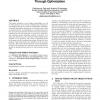UIST
1995
ACM
15 years 1 months ago
1995
ACM
This paper describes some design refinements on marking menus and shows how these refinements embody interesting and relevant design principles for HCI. These refinements are base...
GECCO
2006
Springer
15 years 1 months ago
2006
Springer
This paper introduces a new design methodology (we call it "innovization") in the context of finding new and innovative design principles by means of optimization techni...
SIGSOFT
2000
ACM
15 years 1 months ago
2000
ACM
Academic research sometimes suffers from the “ivory tower” problem: some ideas that sound good in theory do not necessarily work well in practice. An example of research that ...
HICSS
2002
IEEE
15 years 2 months ago
2002
IEEE
Project teams have become an important element in teaching informatics. Web-based groupware systems are increasingly used in such educational settings. This kind of educational te...
ACSAC
2003
IEEE
15 years 2 months ago
2003
IEEE
General-purpose operating systems provide a rich computing environment both to the user and the attacker. The declining cost of hardware and the growing security concerns of softw...
CSCW
2004
ACM
15 years 2 months ago
2004
ACM
The needs of blind and visually impaired users are seriously under-investigated in CSCW. We review work on assistive interfaces especially concerning how collaboration between sig...
CSCW
2004
ACM
15 years 2 months ago
2004
ACM
Under-contribution is a problem for many online communities. Social psychology theories of social loafing and goal-setting can provide mid-level design principles to address this ...
TSD
2005
Springer
15 years 3 months ago
2005
Springer
The aim of the work described in this paper is to extend the EPFL dialogue platform with multimodal capabilities. Based on our experience with the EPFL Rapid Dialogue Prototyping M...
WIKIS
2006
ACM
15 years 3 months ago
2006
ACM
In this paper we ask to what extent collective cognition can be supported and sustained in classroom practices. One major challenge for learning in technology-rich, collaborative ...
WMTE
2006
IEEE
15 years 3 months ago
2006
IEEE
Ubiquitous computing, as a subfield of computer science, has traditionally been associated with a set of principles expressed (loosely but tellingly) with terms like transparency,...



